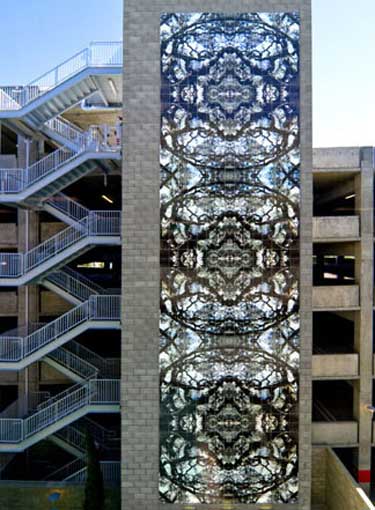Artist:
Ken Gonzales-Day
Title:
California Landscape
Year:
2007
Adress:
8300 S. Vermont Avenue
www.crala.org:
Images of idyllic California landscapes by photographer Ken Gonzales-Day scaled to the size of large movie screens are installed at the Los Angeles County Administrative Building, located on Vermont Avenue between 83rd and 84th Streets in South Los Angeles.
The colorful art work entitled California Landscapes, Variations 1 through 4 were completed as Gonzales-Day’s first public art commission. The ceramic-tiled murals are on both interior and exterior walls of the building. The largest of these photographic murals—a kaleidoscopic arrangement of oak trees—is 54-feet high, 15-feet wide and appears on the parking structure adjacent to an open-air plaza and the office building.
Together with the art mural installations, the Los Angeles County Administrative Building is a catalyst for urban renewal efforts in south central Los Angeles.
www.kengonzalesday.com:
Ken Gonzales-Day’s interdisciplinary and conceptually grounded projects consider the history of photography, the construction of race, and the limits of representational systems ranging from the lynching photograph to museum display.
www.lenscratch.com:
What his research uncovered, was that contrary to popular belief, African Americans were not the only targets of lynching in California and the west. In fact, Gonzales-Day was also able to document the lynching of Latinos, Native Americans, and Chinese immigrants, at least in part due to their racial identity. In doing so, Gonzales-Day has revealed a history of violence against immigrants in the west that still goes on today, with mass incarceration and family separation taking place at our borders.
The photographs in Searching, which grew out of Gonzales-Day’s labor-intensive research, were no doubt helpful in dealing with the trauma created by exposing these lynchings. They also serve as a testament to what Gonzales-Day calls an 'invisible history.' That being the 'history of racial hatred that had taken place in the California landscape.'
www.wikipedia.org:
Ken Gonzales-Day (born 1964) is a Los Angeles-based conceptual artist best known for interdisciplinary projects that examine the historical construction of race, identity, and systems of representation including lynching photographs, museum display and street art. His widely exhibited "Erased Lynching" photographic series and book, Lynching in the West: 1850-1935 (2006), document the absence in historical accounts of the lynching of Latinos, Native Americans and Asians in California's early history. The series has toured in traveling exhibitions staged by the Los Angeles County Museum of Art (LACMA), Smithsonian Institution and Minnesota Museum of American Art, and appeared at the Tamayo Museum (Mexico City), Generali Foundation (Vienna) and Palais de Tokyo in Paris, among other venues.
Los Angeles Times critic Holly Myers writes that Gonzales-Day's work conveys "a palpable quality of tenderness" through a "delicate form of visual ethics" that explores racial tendencies, perceptions and presumptions "without pinning the dialogue to actual individuals"; curator Gonzalo Casals describes his method as "simple artistic gesture[s] that allow for the reinterpretation of history, opening up new perspectives and allowing for the voices of the 'other' to rise above the official history."
Images of idyllic California landscapes by photographer Ken Gonzales-Day scaled to the size of large movie screens are installed at the Los Angeles County Administrative Building, located on Vermont Avenue between 83rd and 84th Streets in South Los Angeles.
The colorful art work entitled California Landscapes, Variations 1 through 4 were completed as Gonzales-Day’s first public art commission. The ceramic-tiled murals are on both interior and exterior walls of the building. The largest of these photographic murals—a kaleidoscopic arrangement of oak trees—is 54-feet high, 15-feet wide and appears on the parking structure adjacent to an open-air plaza and the office building.
Together with the art mural installations, the Los Angeles County Administrative Building is a catalyst for urban renewal efforts in south central Los Angeles.
www.kengonzalesday.com:
Ken Gonzales-Day’s interdisciplinary and conceptually grounded projects consider the history of photography, the construction of race, and the limits of representational systems ranging from the lynching photograph to museum display.
www.lenscratch.com:
What his research uncovered, was that contrary to popular belief, African Americans were not the only targets of lynching in California and the west. In fact, Gonzales-Day was also able to document the lynching of Latinos, Native Americans, and Chinese immigrants, at least in part due to their racial identity. In doing so, Gonzales-Day has revealed a history of violence against immigrants in the west that still goes on today, with mass incarceration and family separation taking place at our borders.
The photographs in Searching, which grew out of Gonzales-Day’s labor-intensive research, were no doubt helpful in dealing with the trauma created by exposing these lynchings. They also serve as a testament to what Gonzales-Day calls an 'invisible history.' That being the 'history of racial hatred that had taken place in the California landscape.'
www.wikipedia.org:
Ken Gonzales-Day (born 1964) is a Los Angeles-based conceptual artist best known for interdisciplinary projects that examine the historical construction of race, identity, and systems of representation including lynching photographs, museum display and street art. His widely exhibited "Erased Lynching" photographic series and book, Lynching in the West: 1850-1935 (2006), document the absence in historical accounts of the lynching of Latinos, Native Americans and Asians in California's early history. The series has toured in traveling exhibitions staged by the Los Angeles County Museum of Art (LACMA), Smithsonian Institution and Minnesota Museum of American Art, and appeared at the Tamayo Museum (Mexico City), Generali Foundation (Vienna) and Palais de Tokyo in Paris, among other venues.
Los Angeles Times critic Holly Myers writes that Gonzales-Day's work conveys "a palpable quality of tenderness" through a "delicate form of visual ethics" that explores racial tendencies, perceptions and presumptions "without pinning the dialogue to actual individuals"; curator Gonzalo Casals describes his method as "simple artistic gesture[s] that allow for the reinterpretation of history, opening up new perspectives and allowing for the voices of the 'other' to rise above the official history."



